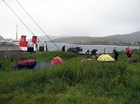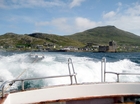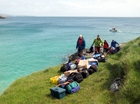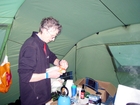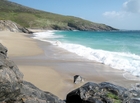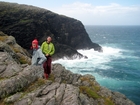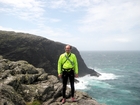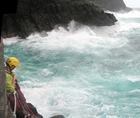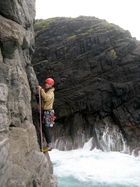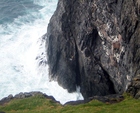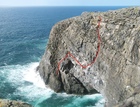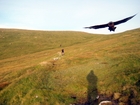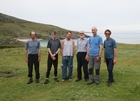July 2010. Report by: Patrick Winter
Present:
- Dave Amos
- Michael Pettipher
- Martin Hampur
- Bryan Rynne
- Francis Winter
- Patrick Winter
Despite their remoteness and consequent difficulties in access the outer Hebridean Islands of Mingulay and Pabbay have been attracting a steady stream of enthusiastic British climbers for a number of years. Many fantastic crags have been developed and while many of the most celebrated climbs are in the upper end of the grades spectrum (well E3 or more!) there is still much to interest those who climb at a more modest level. With this in mind, a small group of JMCS along with a couple of mountaineering associates from Manchester planned a visit to these islands this summer.
The first two weeks in July are often wet and windy in Scotland - that is of course because it coincides with the Edinburgh and Glasgow trades holidays - but unfortunately this was the only time that was convenient for all of us to make this trip.
The weather did not disappoint! - it was indeed wild wet and windy and our Calmac ferry to Barra from Oban from which an onward journey to these islands is usually made was delayed by about three hours. We arrived at 12.30 am tired and slightly sea sick and scratched around in wind and rain looking for somewhere to camp the night.
The next day our privately chartered ferry that was to take us to Mingulay was cancelled due to further inclement weather. Eventually we set sail the following day. Our charming ferry man, Donald McLeod of Barra Fishing Charters said that given the conditions and forecast for the week ahead we had better choose between Mingulay and Pabbay. Originally we had hoped to visit both islands. All things considered we plumped for Mingulay which is the larger of the two islands. I was disappointed knowing that this ruled out climbing the iconic ‘Prophesy of Drowning’ E2 on Pabbay which was perhaps the single most reason for making the trip in the first place.
After a fairly rough passage we disembarked on Mingulay and had to haul about half a ton of gear etc up steep slippery rocks and then a further 150 yards of boggy ground to our camping spot. Some climbing trips are such fun!!
As well as our own individual tents, we had a large mess tent for cooking, dining and general communing, acquired at half price from Halford’s spring sale. During the next week this tent was subjected to some very strong winds but a few boulders the size of large pumpkins kept it from being blown away.
Our camping spot was next to some old ruins ([Mingulay has been uninhabited for nearly a century), overlooking a lovely sandy bay on which scores of seals had settled for the summer.
I had been dreading midges at the camping spot and had come prepared with all manner of candle and josh stick insect repellents but the upside of windy weather meant that they did not bother us one bit/e!
We spent the week exploring the island and climbing when the weather and swell of the sea permitted. We had hoped to climb on Dun Mingulay, the most significant cliff on the island and host to many highly esteemed routes but unfortunately conditions were always too stormy when we went there.
Out of only a handful of climbs we managed, the best was undoubtedly The Arch Deacon HVS, a very airy four star classic, first climbed by Mick Tighe (former guest speaker at a JMCS Dinner - remember him?). To get to the base of the climb necessitated a long and quite scary rappel on our new 100 metre static abseil rope. Despite coiling the lower end at least 10 metres out of the sea on our initial belay stance, some extra large waves lashed across the stance (after we had departed) and swept it into the sea, whereupon it proceeded to get hopelessly snagged around rocks. An expedition to free it the next day failed and we had to cut it free, thus losing about 20 metres of it to the sea!
Despite the lack of climbing achieved this was a very pleasant and relaxing holiday. The sense of seclusion of being on a remote uninhabited island, dodging the local hawkish bonxies [Great Skuas that will make a bee-line for your head if you go too close to their nests], the seals, and the camaraderie of our group united in adversity, and the wonderful scenery on the island.
